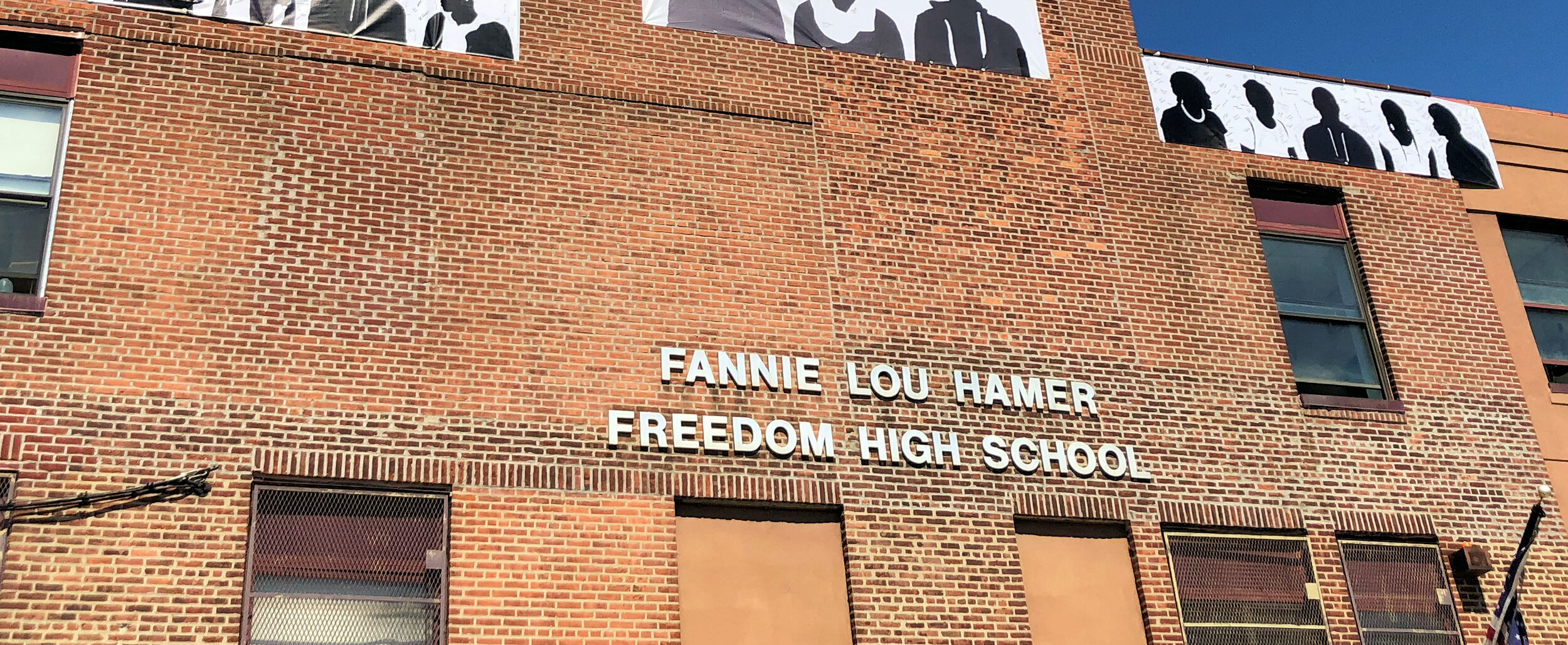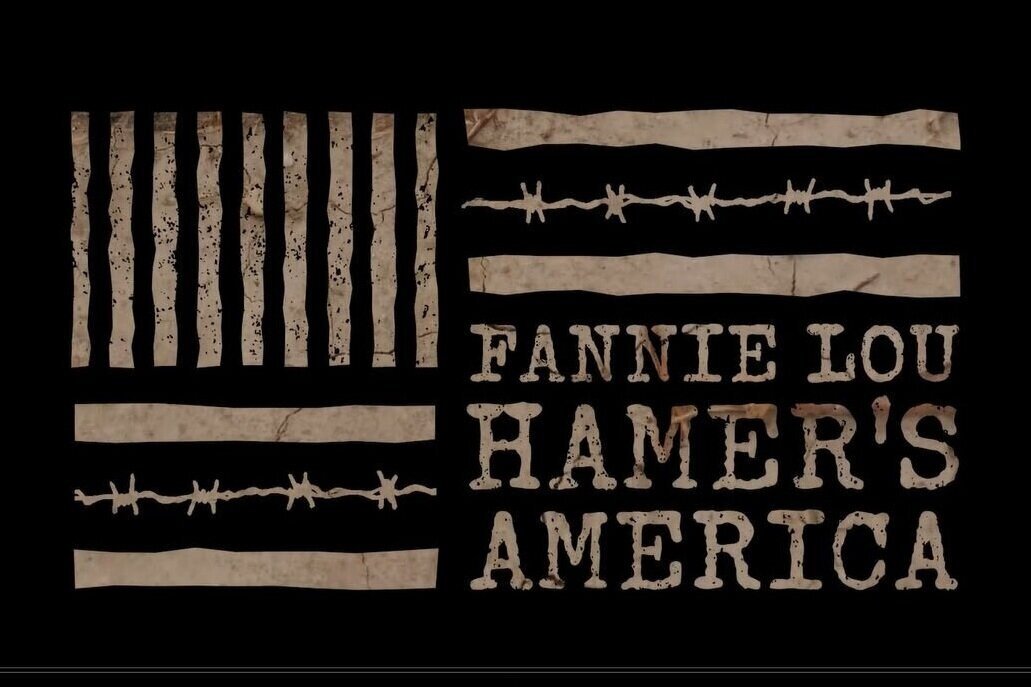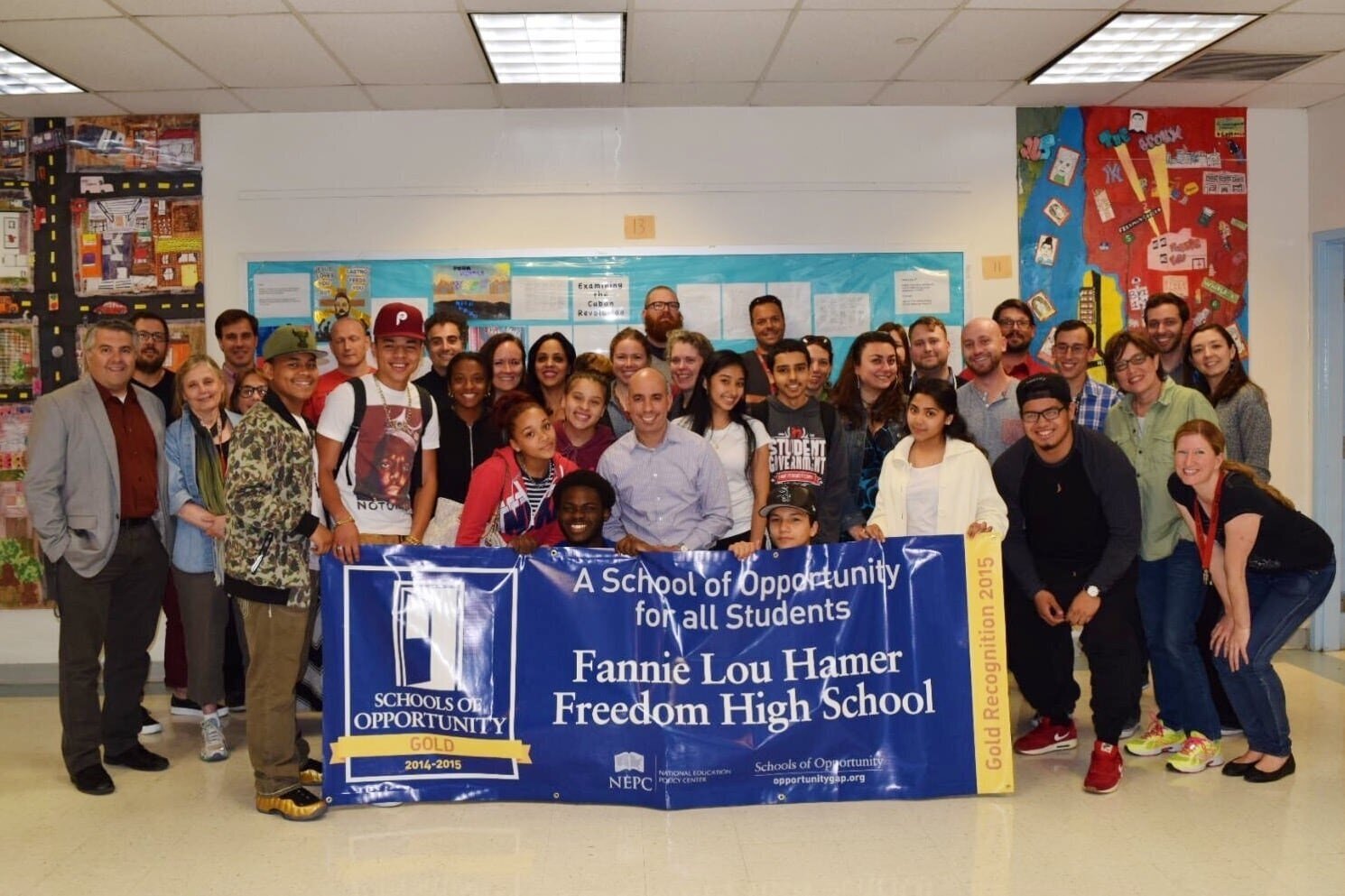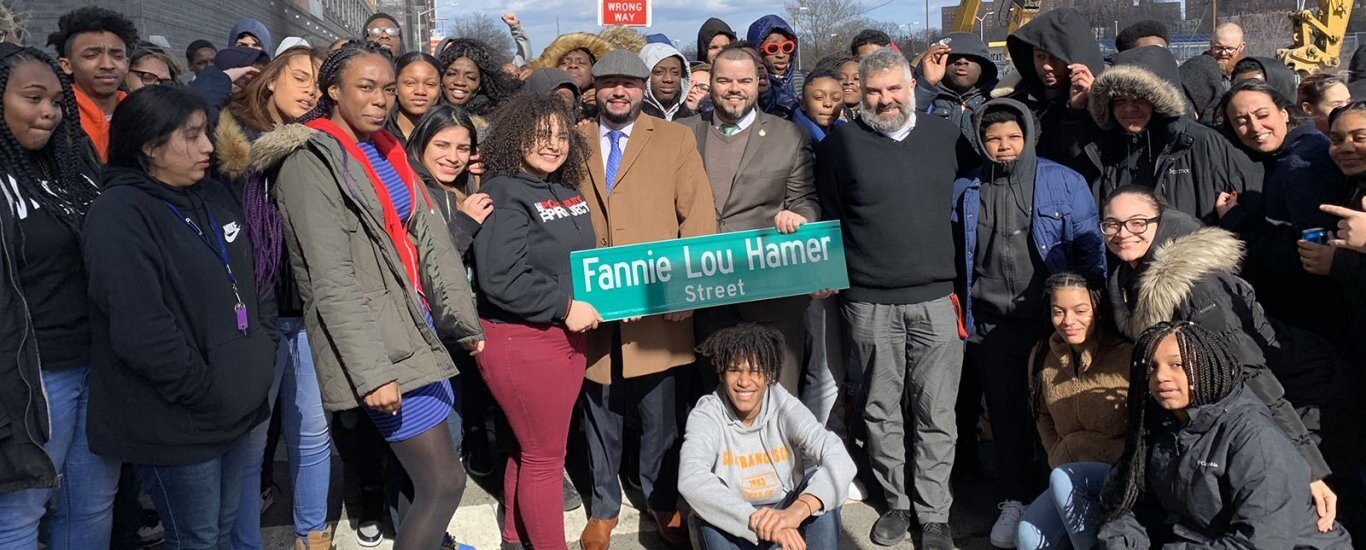Fannie Lou Hamer Freedom High School
1021 Jennings Street, Bronx, New York

Opened in 1994, the Fannie Lou Hamer Freedom High School has always stood up to the injustice that plagues our society, while teaching their students to use education to enact social change. Peter Steinberg, who served as its first director and principal, said his motivation for naming the school, after his ‘shero’ Fannie Lou Hamer, came when he noticed the similarities between the systematic oppression of Blacks in Mississippi that Hamer fought so hard for, to the young people of the Bronx in the early 1980s.“When I designed the school, based largely on the Central Park East Secondary School model, I knew that it would open in the poorest congressional district in the nation and that its students and families were facing a daily social, political, and economic oppression which was strikingly similar to that which Mississippi blacks faced in the 1960's and continue to struggle against,” he said. “The oppression faced in the 1984 Bronx was not as open and not sanctioned by law, but it was every bit as real and destructive of the souls and lives of the people of the South Bronx.”Steinberg said the young people then preferred to fight with each other, often through gangs, rather than work together to oppose the very sources that were at the root of their oppression. And they particularly rebelled against school systems that couldn’t relate to the reality of their lives and communities. “They had few expectations and little hope for the future,” Steinberg said. “It was…And it was in this environment that we were introducing new small schools.” FLHFHS has Gold Recognition as a "School of Opportunity" from the National Education Policy Center.
One of Fannie Lou Hamer's most famous quotes, "Nobody's Free Until Everybody's Free" appears on the walls of the High School and Middle School.
Students from the high school participated in a project that built nesting boxes for tree swallows and monitored American eels as part of the Rocking The Boat program.
Steinberg said "Fannie Lou Hamer" was only the first part of the new school’s name. The second part - "Freedom" was also essential. That was taken specifically from the 1964 Freedom Summer in Mississippi where more than a thousand mainly relatively young people flooded the state to organize and encourage Black people to register and vote. Fannie Lou Hamer played an instrumental role in organizing that Summer and in establishing "Freedom Schools" throughout the state during a time when Black young people, most often for the first time, would begin to learn about Black history, the reality of oppression, the value of basic academic skills, and, perhaps most importantly, the personal role they could play in fighting injustice. The philosophy of these schools came mainly from the Highlander School in Tennessee and it was so people could become agents in their own liberation. "Freedom school teachers were trained to ask students questions and challenge them to find their own solutions." “That philosophy was strikingly similar to the principles of the Coalition of Essential Schools, the basis for our new schools,” Steinberg said. Fannie Lou Hamer Freedom High School is a community that focuses on preparing students to live productive, socially useful, and personally satisfying lives. They currently have 39 teachers, and 522 students in grades 9 through 12 who are being taught to develop and pursue their interests with well-developed literacy, quantitative and critical thinking, as well as problem-solving skills. The school boasts a STEAM Room and a rooftop garden. Described as a “well-run school that follows a progressive model”, the high school gained Gold Recognition as a "School of Opportunity" from the National Education Policy Center for “creating a healthy environment for students, teachers and staff.”Jeff Palladino has been the school’s principal since 2013. At 5'11, Fannie Lou Panthers' guard, Frankie Williams prevails over his Woodmere opponent.
A vigorous workout.
Fannie Lou Coach Marc Skelton (kneeling) strategizes with his team.
Members of the boy's basketball team.
The Fannie Lou Hamer Freedom High School boys basketball team, under coach Marc Skelton is not only a championship team, but they also have a 100 percent graduation rate.“Fannie Lou Hamer had been a personal hero of mine…since she spoke before the Credentials Committee at the Democratic Party National Convention in 1964. She spoke as a representative of the Mississippi Freedom Democratic Party which was challenging the seating of a segregated regular Democratic Party delegation. And she electrified the country as she described her own awakening to the civil rights movement in 1962, her efforts to register to vote, and the brutality she faced when arrested on June 9, 1963, in Winona, Mississippi after encouraging others to exercise their democratic rights.”– Peter SteinbergFannie Lou Hamer Street
Bronx, New York
“Before attending high school I had never even heard of Fannie Lou Hamer. Then I started to attend Fannie Lou Hamer Freedom High School and learned she was an activist from Mississippi who worked to give African-Americans to vote. Most of the time when I heard about activists it was about Martin Luther King Jr or Malcolm X. Fannie Lou was beaten by racist police officers but she didn’t let that stop her from continuing to organize people to vote. When I heard about that incident, that was the moment I realized Fannie Lou was awesome!” - Janine Castro, Fannie Lou Hamer Freedom High School SophomoreFannie Lou Hamer Freedom High School Principal Jeff Palladino proudly displays the new street sign.
Student Janine Castro and Councilman Rafael Salamanca, of the 17th District, prepare to unveil the new sign.
The new sign as installed off East 172nd Street in the Bronx.
Assemblyman Marcos Crespo pulls the veil that displays the new Fannie Lou Hamer Street sign across the street from the high school.
A student reads her letter petitioning for West Farms Street to be renamed for Fannie Lou Hamer.
Janine Castro and other students celebrate their efforts to rename West Farms Street for their school's namesake, Fannie Lou Hamer.
It was the students of Fannie Lou Hamer Freedom High School who petitioned to have West Farms Street in the Bronx, renamed for civil rights icon, and their school’s namesake, Fannie Lou Hamer. And it was student, Janine Castro, then a sophomore, whose essay clinched the effort. She shared her story with the media: “Last school year (2017) was Fannie Lou’s 100th birthday and our school celebrated in many ways. My teacher, Christine Caldero, held a competition to see who could write a persuasive essay on changing the street name in front of our building to Fannie Lou Hamer Street. I started to research as many things about Fannie Lou as possible, submitted my paper, and won the competition. To my surprise, Christine submitted my paper to the local community board. The community board took our request seriously and invited the school to present the request for the street name change at the next community board meeting. I was given the honor of speaking in front of the community board and was so nervous I felt like a baby bird about to take its first flight. I thought that I would mess up, but it was great. I received great feedback from community board members and on the first vote, they voted yes! I was also joined by my friend Cinia Simpson, representatives from our student government, my teachers Paula Dallacqua and Christine Caldero, and Principal Jeff Palladino.After the meeting, months went by and I didn’t hear anything about the street naming. I was worried that I was going to graduate and the street was still going to be the same. I thought that the hard work that we did was for nothing. Then in January 2019 we went to Atlantic City for a march honoring Fannie Lou and marched to the same convention center where she famously spoke out about African-American rights on live television. The march was amazing and gave me the inspiration I needed to not give up on the street naming.Finally, on February 15, 2019, my principal Jeff Palladino informed me the street naming would actually happen on February 25 in partnership with our local elected officials, Councilmember Rafael Salamanca and Assembly member Marcos Crespo. I would also have the opportunity to speak at the ceremony. I was so happy that I cried. Fannie Lou Hamer put in so much work to fight for civil rights, which are the rights for African-Americans to be seen as human beings. I knew we worked hard for this moment to happen and that the street naming was long overdue. I was so happy that what we did together as a school and a community was big enough to have the street name changed.Being able to have a role in changing the street name to Fannie Lou Hamer Street was a great honor for me. This amazing experience started with what I thought was just a little competition. I never knew it would bloom into this beautiful flower.”Fannie Lou Hamer Middle School
1001 Jennings Street, 5th Floor, Bronx, New York
“Nobody’s free until everybody’s free.” - Fannie Lou Hamer
A mural painted by students decorates the building that houses the Middle School in the Bronx.
The Middle School was named by students at the Fannie Lou Hamer Freedom High School across the street.
Opened during the 2004-2005 school year, Fannie Lou Hamer Middle School accommodates students from 6th to 8th grade and spawned from the Fannie Lou Hamer Freedom High School across the street. Located on the 5th floor, the middle school shares a building with PS 66, a neighborhood school serving grades 3-K through 5. The mission of the Fannie Lou Hamer Middle School is to: “Equip students with the skills necessary to advocate for themselves, others, and their world through critical thinking, effective work habits, and compassionate actions.” Abbey Wilson, who has served as principal since 2016, said students from the Middle School and High School painted the mural during the summer of 2021. Those students attended the Summer Rising Program at the school and worked in partnership with Thrive Collective for the purpose of highlighting and amplifying the power of student voices and working with past community leaders. Students participating in Roundtables, where they presented a project not only to their fellow classmates, but also to relatives and members of the community.
Students collect and write their thoughts during class.
Two dedicated teachers from the school host a booth at the Bronx Early Hiring Fair.
Fannie Lou Hamer Middle School partnered with @nycthrive to paint the mural on the school's building.
Another student works on the new mural.
Teachers and students attend the ribbon cutting ceremony for the new mural painted on the school.
As part of making schools in New York City more sustainable, educators strive to inspire students, teachers, parents, and school communities to take part in environmental programs. These Recycling Troopers from the Middle School attended an expo to see what other schools were doing in that area and how to improve on their own methods.
Fannie Lou Hamer Middle School’s Vision:
“Engaging and empowering all students to advocate for themselves and their world and play an active role in building and participating in resilient and vibrant communities.”
Eighth-grade graduates from the 2021 class.
Seventh-graders from Fannie Lou Hamer Middle School took a college trip to Washington D.C. in 2019 to tour Howard University and other historical sites.
PS66 Principal Kevin Goodman and FLHMS Principal Abbey Wilson.
Students and staff star in a virtual performance of Shrek the Musical.
Students celebrate a Sing for Hope piano delivered to the school painted by Lola Lovenotes!
During the COVID-19 pandemic in 2020, teachers at the Middle School put together mini at-home reference library packs for students for remote learning.
Students were served refreshing strawberries and cantaloupe in the cafeteria during Fresh Fruit Week.
Hot off the presses! Produced by student writers and editors, the Fannie Lou News helps students to express themselves creatively.
Fannie Lou Hamer Middle School’s Instructional Focus:
“Inspiring students, teachers, parents, and school communities to take part in environmental programs. Promoting everyday practices that benefit the environment.”
Fannie Lou Hamer Middle School Stats:
Founding Principal: Lorraine Chanon
Current Principal: Abbey Wilson
Assistant Principal: Stephen Walton
Number of Students: 290
Number of Teachers: 30-35

































